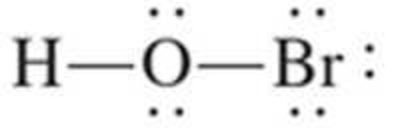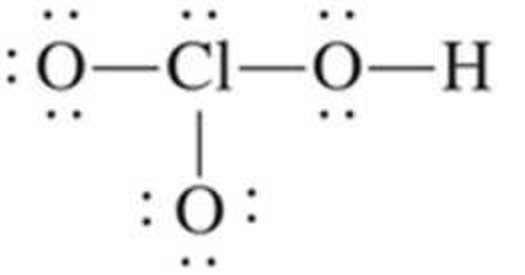
EBK GENERAL, ORGANIC, AND BIOLOGICAL CH
7th Edition
ISBN: 9780100853188
Author: STOKER
Publisher: YUZU
expand_more
expand_more
format_list_bulleted
Concept explainers
Textbook Question
Chapter 5, Problem 5.26EP
Identify the coordinate covalent bond(s) present, if any, in each of the following molecules by listing the two atoms involved in the bond. Name the atom on the left or the bottom in the bond first.




Expert Solution & Answer
Trending nowThis is a popular solution!

Students have asked these similar questions
What is the net ionic equation for the reaction between tin(IV) sulfide and nitric acid?
The combustion of 28.8 g of NH3 consumes exactly _____ g of O2.
4 NH3 + 7 O2 ----> 4 NO2 + 6 H2O
What is the molecular formula of the bond-line structure shown below
OH
HO
○ C14H12O2
○ C16H14O2
○ C16H12O2
O C14H14O2
Chapter 5 Solutions
EBK GENERAL, ORGANIC, AND BIOLOGICAL CH
Ch. 5.1 - Covalent bond formation most often involves...Ch. 5.1 - Which of the following concepts is closely...Ch. 5.1 - Prob. 3QQCh. 5.1 - Prob. 4QQCh. 5.2 - Prob. 1QQCh. 5.2 - Prob. 2QQCh. 5.2 - Prob. 3QQCh. 5.2 - Prob. 4QQCh. 5.2 - Prob. 5QQCh. 5.2 - Prob. 6QQ
Ch. 5.3 - Prob. 1QQCh. 5.3 - Prob. 2QQCh. 5.3 - Prob. 3QQCh. 5.3 - Prob. 4QQCh. 5.3 - Prob. 5QQCh. 5.4 - Prob. 1QQCh. 5.4 - Prob. 2QQCh. 5.4 - Prob. 3QQCh. 5.5 - Which of the following is an incorrect statement...Ch. 5.5 - Prob. 2QQCh. 5.5 - Prob. 3QQCh. 5.6 - Prob. 1QQCh. 5.6 - Prob. 2QQCh. 5.6 - Prob. 3QQCh. 5.6 - Prob. 4QQCh. 5.6 - Prob. 5QQCh. 5.7 - Prob. 1QQCh. 5.7 - Prob. 2QQCh. 5.7 - Prob. 3QQCh. 5.8 - Prob. 1QQCh. 5.8 - In VSEPR theory, an angular molecular geometry is...Ch. 5.8 - Prob. 3QQCh. 5.8 - Prob. 4QQCh. 5.8 - Prob. 5QQCh. 5.9 - Prob. 1QQCh. 5.9 - Prob. 2QQCh. 5.9 - Prob. 3QQCh. 5.9 - Prob. 4QQCh. 5.10 - Prob. 1QQCh. 5.10 - Prob. 2QQCh. 5.10 - Prob. 3QQCh. 5.10 - As the difference in electronegativity between two...Ch. 5.10 - Prob. 5QQCh. 5.10 - Prob. 6QQCh. 5.11 - Prob. 1QQCh. 5.11 - Prob. 2QQCh. 5.11 - Prob. 3QQCh. 5.11 - Prob. 4QQCh. 5.11 - Prob. 5QQCh. 5.12 - Prob. 1QQCh. 5.12 - Prob. 2QQCh. 5.12 - Prob. 3QQCh. 5.12 - Prob. 4QQCh. 5.12 - Prob. 5QQCh. 5.12 - Prob. 6QQCh. 5 - Contrast the types of elements involved in ionic...Ch. 5 - Contrast the mechanisms by which ionic and...Ch. 5 - Prob. 5.3EPCh. 5 - Prob. 5.4EPCh. 5 - Indicate whether or not covalent bond formation is...Ch. 5 - Indicate whether or not covalent bond formation is...Ch. 5 - Draw Lewis structures to illustrate the covalent...Ch. 5 - Draw Lewis structures to illustrate the covalent...Ch. 5 - How many nonbonding electron pairs are present in...Ch. 5 - How many nonbonding electron pairs are present in...Ch. 5 - The component elements for four binary molecular...Ch. 5 - The component elements for four binary molecular...Ch. 5 - Specify the number of single, double, and triple...Ch. 5 - Specify the number of single, double, and triple...Ch. 5 - Convert each of the Lewis structures in Problem...Ch. 5 - Convert each of the Lewis structures in Problem...Ch. 5 - Prob. 5.17EPCh. 5 - Prob. 5.18EPCh. 5 - Prob. 5.19EPCh. 5 - Identify the Period 3 nonmetal that would normally...Ch. 5 - How many valence electrons do atoms possess that...Ch. 5 - Prob. 5.22EPCh. 5 - What aspect of the following Lewis structure...Ch. 5 - What aspect of the following Lewis structure...Ch. 5 - Identify the coordinate covalent bond(s) present,...Ch. 5 - Identify the coordinate covalent bond(s) present,...Ch. 5 - Without actually drawing the Lewis structure,...Ch. 5 - Without actually drawing the Lewis structure,...Ch. 5 - Prob. 5.29EPCh. 5 - Prob. 5.30EPCh. 5 - Draw the Lewis structure for each of the molecules...Ch. 5 - Draw the Lewis structure for each of the molecules...Ch. 5 - Draw Lewis structures to illustrate the bonding in...Ch. 5 - Draw Lewis structures to illustrate the bonding in...Ch. 5 - How many electron dots should appear in the Lewis...Ch. 5 - Prob. 5.36EPCh. 5 - Draw Lewis structures for the following polyatomic...Ch. 5 - Draw Lewis structures for the following polyatomic...Ch. 5 - Draw Lewis structures for the following compounds...Ch. 5 - Draw Lewis structures for the following compounds...Ch. 5 - Draw Lewis structures for the following molecules...Ch. 5 - Draw Lewis structures for the following molecules...Ch. 5 - In which of the following pairs of diatomic...Ch. 5 - In which of the following pairs of diatomic...Ch. 5 - Prob. 5.45EPCh. 5 - What is the molecular geometry associated with...Ch. 5 - Specify the molecular geometry of each of the...Ch. 5 - Specify the molecular geometry of each of the...Ch. 5 - Prob. 5.49EPCh. 5 - Prob. 5.50EPCh. 5 - Prob. 5.51EPCh. 5 - Prob. 5.52EPCh. 5 - Prob. 5.53EPCh. 5 - Prob. 5.54EPCh. 5 - Using VSEPR theory, predict the molecular geometry...Ch. 5 - Using VSEPR theory, predict the molecular geometry...Ch. 5 - Prob. 5.57EPCh. 5 - Specify both the VSEPR electron group geometry...Ch. 5 - Prob. 5.59EPCh. 5 - Prob. 5.60EPCh. 5 - Using a periodic table, but not a table of...Ch. 5 - Using a periodic table, but not a table of...Ch. 5 - Prob. 5.63EPCh. 5 - Prob. 5.64EPCh. 5 - Place + above the atom that is relatively positive...Ch. 5 - Place + above the atom that is relatively positive...Ch. 5 - Rank the following bonds in order of increasing...Ch. 5 - Rank the following bonds in order of increasing...Ch. 5 - Classify each of the following bonds as nonpolar...Ch. 5 - Classify each of the following bonds as nonpolar...Ch. 5 - Prob. 5.71EPCh. 5 - Prob. 5.72EPCh. 5 - Fill in the blanks in each line of the following...Ch. 5 - Fill in the blanks in each line of the following...Ch. 5 - Four hypothetical elements, A, B, C, and D, have...Ch. 5 - Four hypothetical elements, A, B, C, and D, have...Ch. 5 - Indicate whether each of the following...Ch. 5 - Prob. 5.78EPCh. 5 - Indicate whether each of the following triatomic...Ch. 5 - Indicate whether each of the following triatomic...Ch. 5 - Indicate whether each of the following molecules...Ch. 5 - Indicate whether each of the following molecules...Ch. 5 - Prob. 5.83EPCh. 5 - Prob. 5.84EPCh. 5 - Indicate which molecule in each of the following...Ch. 5 - Indicate which molecule in each of the following...Ch. 5 - Successive substitution of F atoms for H atoms in...Ch. 5 - Successive substitution of F atoms for H atoms in...Ch. 5 - Prob. 5.89EPCh. 5 - Indicate whether or not each of the following...Ch. 5 - Prob. 5.91EPCh. 5 - Name the following binary molecular compounds? a....Ch. 5 - Prob. 5.93EPCh. 5 - Prob. 5.94EPCh. 5 - Prob. 5.95EPCh. 5 - Prob. 5.96EPCh. 5 - Prob. 5.97EPCh. 5 - Prob. 5.98EPCh. 5 - Write chemical formulas for the following binary...Ch. 5 - Write chemical formulas for the following binary...Ch. 5 - Prob. 5.101EPCh. 5 - Prob. 5.102EPCh. 5 - The compound whose molecles contain one atom of C...Ch. 5 - Prob. 5.104EPCh. 5 - Prob. 5.105EPCh. 5 - The correct name for the compound K2SO4 is not...Ch. 5 - Prob. 5.107EPCh. 5 - Prob. 5.108EP
Knowledge Booster
Learn more about
Need a deep-dive on the concept behind this application? Look no further. Learn more about this topic, biology and related others by exploring similar questions and additional content below.Similar questions
- Check all molecules that are acids on the list below. H2CO3 HC2H3O2 C6H5NH2 HNO3 NH3arrow_forwardFrom the given compound, choose the proton that best fits each given description. a CH2 CH 2 Cl b с CH2 F Most shielded: (Choose one) Least shielded: (Choose one) Highest chemical shift: (Choose one) Lowest chemical shift: (Choose one) ×arrow_forwardConsider this molecule: How many H atoms are in this molecule? How many different signals could be found in its 1H NMR spectrum? Note: A multiplet is considered one signal.arrow_forward
- For each of the given mass spectrum data, identify whether the compound contains chlorine, bromine, or neither. Compound m/z of M* peak m/z of M + 2 peak ratio of M+ : M + 2 peak Which element is present? A 122 no M + 2 peak not applicable (Choose one) B 78 80 3:1 (Choose one) C 227 229 1:1 (Choose one)arrow_forwardShow transformation from reactant to product, step by step. *see imagearrow_forwardCheck the box if the molecule contains the listed item. *See imagearrow_forward
arrow_back_ios
SEE MORE QUESTIONS
arrow_forward_ios
Recommended textbooks for you
 General, Organic, and Biological ChemistryChemistryISBN:9781285853918Author:H. Stephen StokerPublisher:Cengage Learning
General, Organic, and Biological ChemistryChemistryISBN:9781285853918Author:H. Stephen StokerPublisher:Cengage Learning Living By Chemistry: First Edition TextbookChemistryISBN:9781559539418Author:Angelica StacyPublisher:MAC HIGHER
Living By Chemistry: First Edition TextbookChemistryISBN:9781559539418Author:Angelica StacyPublisher:MAC HIGHER- Chemistry: Matter and ChangeChemistryISBN:9780078746376Author:Dinah Zike, Laurel Dingrando, Nicholas Hainen, Cheryl WistromPublisher:Glencoe/McGraw-Hill School Pub Co
 Introductory Chemistry: An Active Learning Approa...ChemistryISBN:9781305079250Author:Mark S. Cracolice, Ed PetersPublisher:Cengage Learning
Introductory Chemistry: An Active Learning Approa...ChemistryISBN:9781305079250Author:Mark S. Cracolice, Ed PetersPublisher:Cengage Learning Chemistry: The Molecular ScienceChemistryISBN:9781285199047Author:John W. Moore, Conrad L. StanitskiPublisher:Cengage Learning
Chemistry: The Molecular ScienceChemistryISBN:9781285199047Author:John W. Moore, Conrad L. StanitskiPublisher:Cengage Learning

General, Organic, and Biological Chemistry
Chemistry
ISBN:9781285853918
Author:H. Stephen Stoker
Publisher:Cengage Learning

Living By Chemistry: First Edition Textbook
Chemistry
ISBN:9781559539418
Author:Angelica Stacy
Publisher:MAC HIGHER


Chemistry: Matter and Change
Chemistry
ISBN:9780078746376
Author:Dinah Zike, Laurel Dingrando, Nicholas Hainen, Cheryl Wistrom
Publisher:Glencoe/McGraw-Hill School Pub Co

Introductory Chemistry: An Active Learning Approa...
Chemistry
ISBN:9781305079250
Author:Mark S. Cracolice, Ed Peters
Publisher:Cengage Learning

Chemistry: The Molecular Science
Chemistry
ISBN:9781285199047
Author:John W. Moore, Conrad L. Stanitski
Publisher:Cengage Learning
Types of bonds; Author: Edspira;https://www.youtube.com/watch?v=Jj0V01Arebk;License: Standard YouTube License, CC-BY